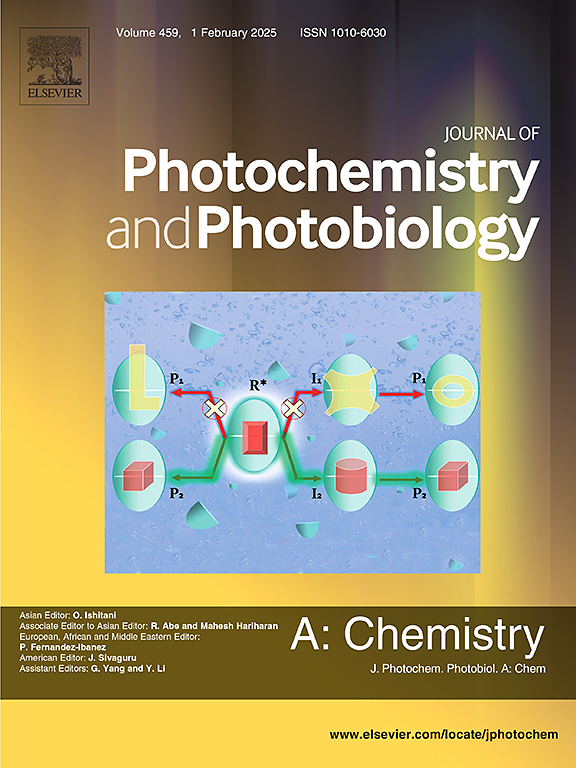Poly (ionic liquid-co-acrylic acid)/oxidized carbon nitride (P/P/O) with enhanced photocatalytic and synergistic bacteriostasis performance
IF 4.1
3区 化学
Q2 CHEMISTRY, PHYSICAL
Journal of Photochemistry and Photobiology A-chemistry
Pub Date : 2025-03-01
DOI:10.1016/j.jphotochem.2025.116367
引用次数: 0
Abstract
Overconsumption of non-renewable energy sources has caused the energy crisis and environmental pollution. Photocatalytic technology can utilize solar energy as a driving force for the energy conversion. Herein, 1-vinyl-3-ethylimidazolium tetrafluoroborate (VEImBF4) and acrylic acid (AA) were used as monomers to prepare poly(1-vinyl-3-ethylimidazolium tetrafluoroborate-co-acrylic acid/ oxidized carbon nitride) (P/P/O) by in situ radical copolymerization with oxygenated graphite carbon nitride (OCN). Specifically, the molecular structure, optical properties, photocatalytic removal of organic pollutants and photocatalytic bacterial inhibition were investigated for different P/P/O ratios. The results showed that P/P/O exhibited excellent light absorption and a high electron-hole separation rate. In addition, it also showed superior photocatalytic removal of MB ability with great cycle stability. Considering the effects of AA and OCN contents on the inhibition performance, P/P/O-2 exhibited the optimal bacteriostatic effect. It can effectively inhibit the growth of E. coli and S. aureus under visible light excitation, which showed the excellent synergistic inhibition performance. The diameters of the inhibition zone of P/P/O-2 on E. coli and S. aureus reached 21.49 mm and 22.36 mm, respectively. Meanwhile, the inhibition rate of P/P/O-2 on E. coli and S. aureus in 24 h reached 98.57 % and 98.59 %, respectively. Simultaneously, the minimum inhibitory concentration (MIC) for E. coli and S. aureus was 0.0469 mg/mL, at the same time, the inhibitory activity of P/P/O was concentration-dependent and broad-spectrum. Therefore, P/P/O with enhanced photocatalytic performance demonstrated its application potential in the field of photocatalytic bacteriostatic or self-cleaning.

求助全文
约1分钟内获得全文
求助全文
来源期刊
CiteScore
7.90
自引率
7.00%
发文量
580
审稿时长
48 days
期刊介绍:
JPPA publishes the results of fundamental studies on all aspects of chemical phenomena induced by interactions between light and molecules/matter of all kinds.
All systems capable of being described at the molecular or integrated multimolecular level are appropriate for the journal. This includes all molecular chemical species as well as biomolecular, supramolecular, polymer and other macromolecular systems, as well as solid state photochemistry. In addition, the journal publishes studies of semiconductor and other photoactive organic and inorganic materials, photocatalysis (organic, inorganic, supramolecular and superconductor).
The scope includes condensed and gas phase photochemistry, as well as synchrotron radiation chemistry. A broad range of processes and techniques in photochemistry are covered such as light induced energy, electron and proton transfer; nonlinear photochemical behavior; mechanistic investigation of photochemical reactions and identification of the products of photochemical reactions; quantum yield determinations and measurements of rate constants for primary and secondary photochemical processes; steady-state and time-resolved emission, ultrafast spectroscopic methods, single molecule spectroscopy, time resolved X-ray diffraction, luminescence microscopy, and scattering spectroscopy applied to photochemistry. Papers in emerging and applied areas such as luminescent sensors, electroluminescence, solar energy conversion, atmospheric photochemistry, environmental remediation, and related photocatalytic chemistry are also welcome.

 求助内容:
求助内容: 应助结果提醒方式:
应助结果提醒方式:


